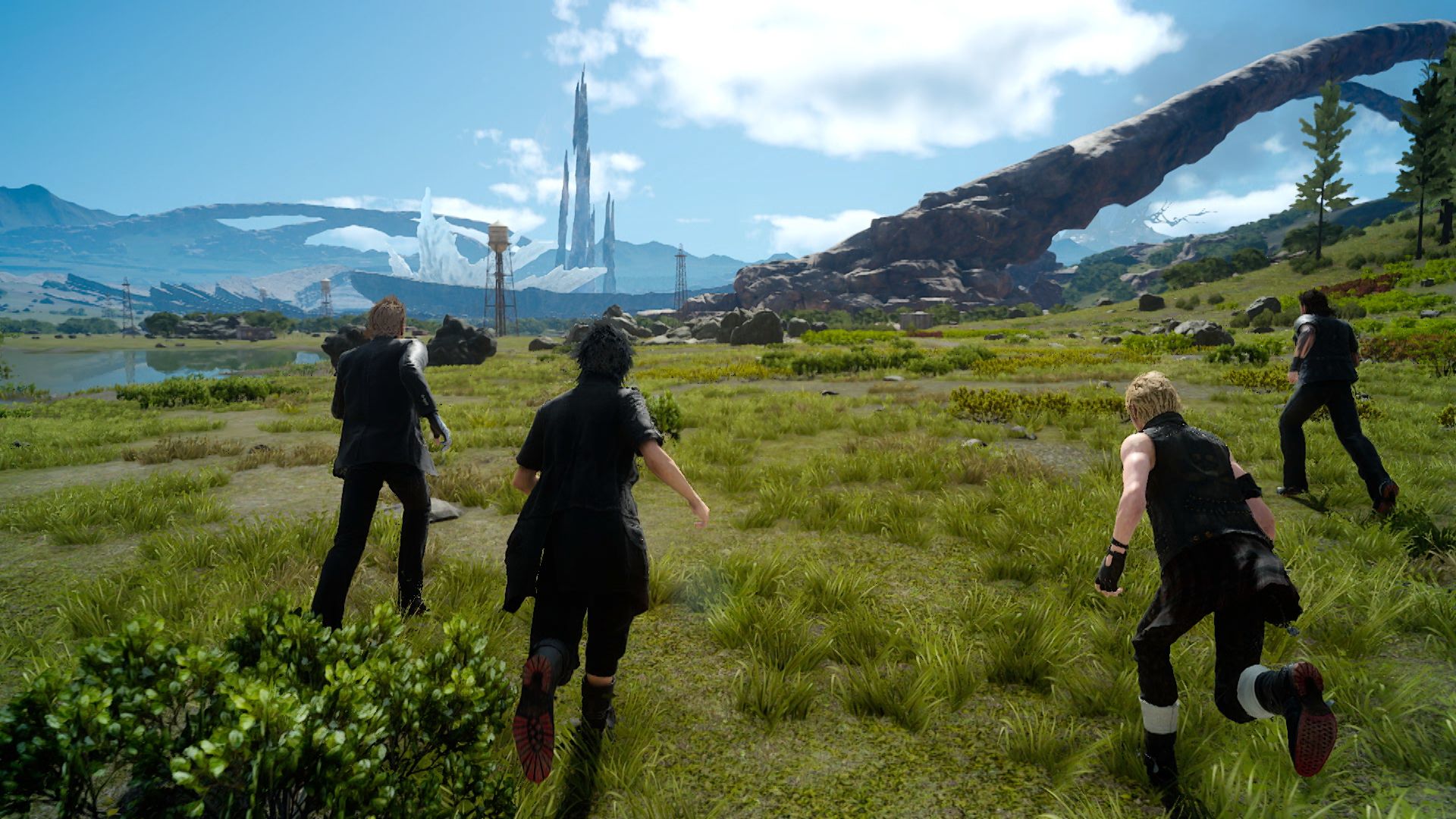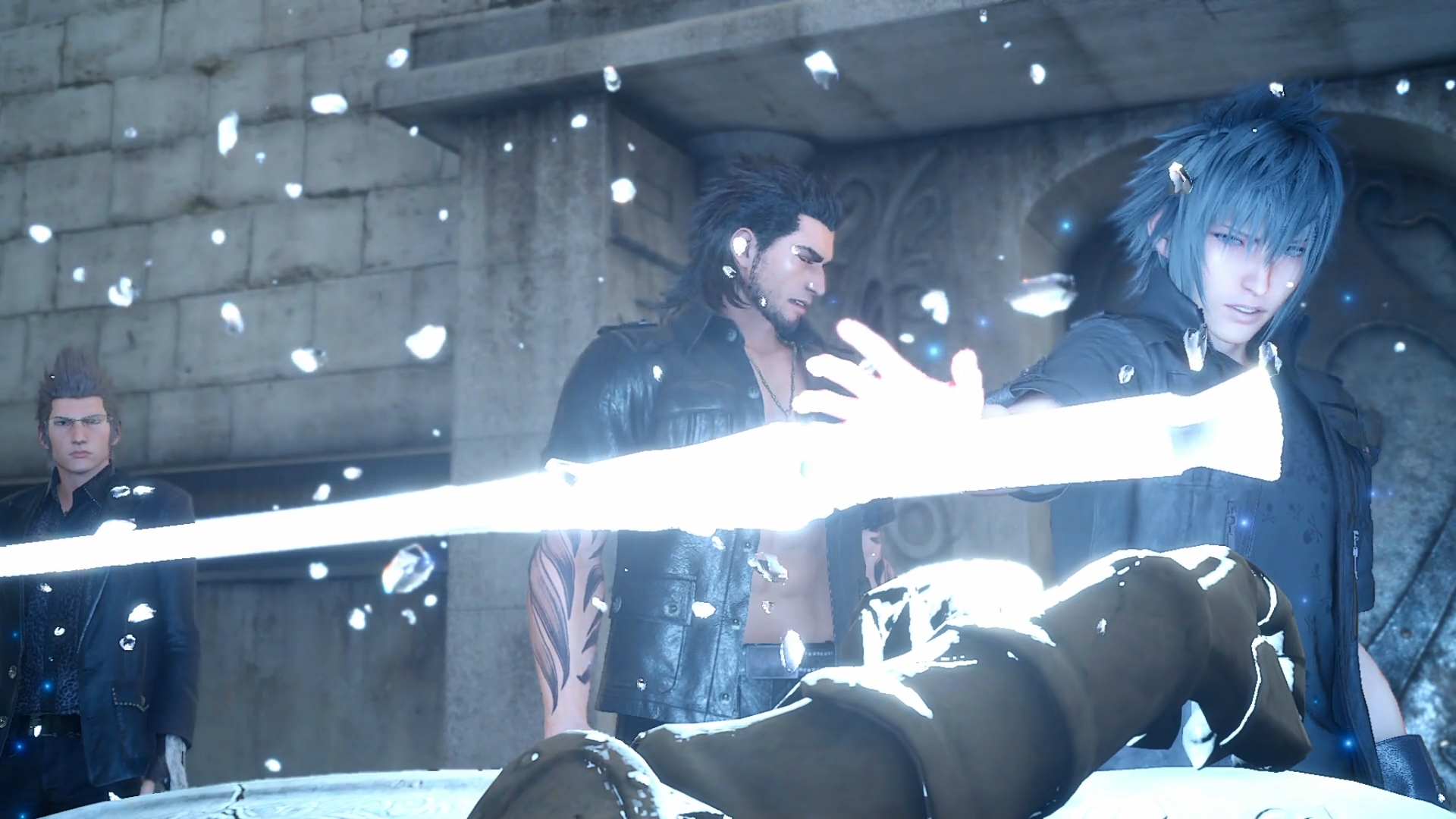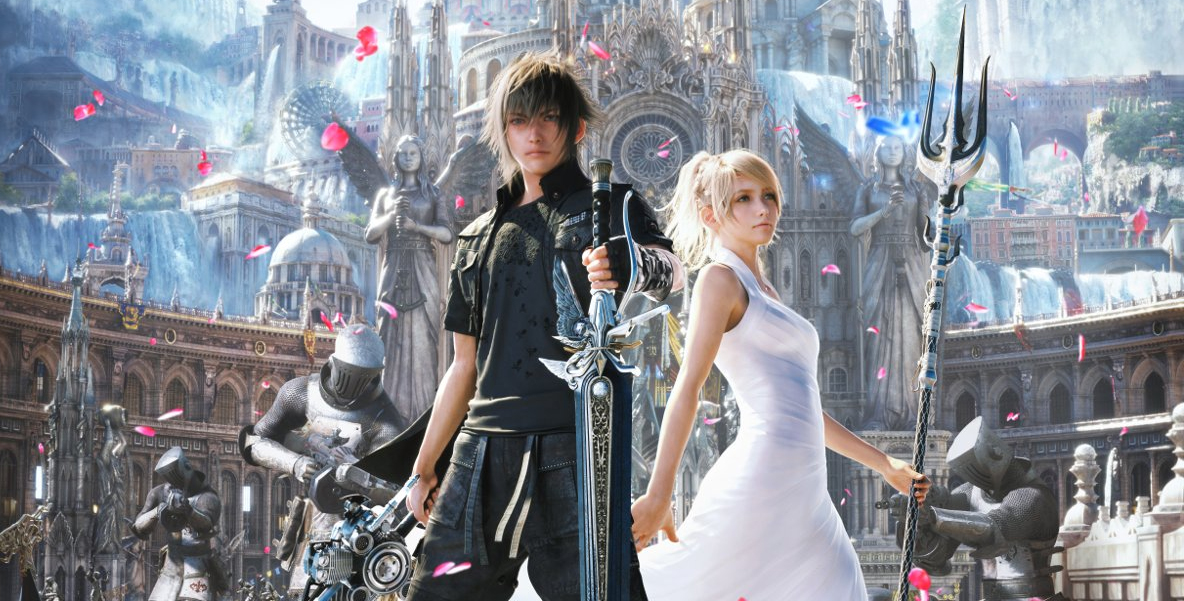A lot’s happened in 10 years but we’re finally here. Final Fantasy XV is real, it’s in our hands and we’ve played it to completion. It’s kind of hard to believe.
Armed with a wonderful soundtrack, a big open world and an action-based battle system, Final Fantasy XV represents a big step for the series. After years of expectations, troubled development, a generational leap and staff changes along with a host of other difficulties and delays the game has shaped up to be an emotional roller coaster of sorts. There’s certainly a lot to say here so let’s get to it.
Shedding the Active Time Battle and turn-based traditions of the series’ past, Final Fantasy XV takes on an action battle system performed in real time. Dubbed “Active Cross Battle,” this system relies on the speed of the player through one-button command presses – attacking, blocking and then parrying as the game sees fit. It’s a system that takes some getting used to – along with its camera – but once you do it becomes a fun romp.
Placed in the shoes of Noctis Lucis Caelum, you’ll solely control Final Fantasy‘s latest hero throughout the entirety of your journey. Your other party members – Ignis, Prompto and Gladiolus – act on AI, though you can issue partner commands during the course of battle to perform special moves and the like. Noctis himself can equip up to four weapon types and switch between them in real time. There’s a ton of freedom here, with each weapon and piece of equipment allowed to be switched out mid-battle.
Along with weapons Noctis can use Magic – though its execution is clunky at best. Venture inside the game’s menu to the crafting screen where you’ll select one of three main elements and combine them alone or together with various items to create powerful spells. Magic itself works in an unconventional way – your characters throw out grenade-type items through unwieldy aiming. Unlike previous games, however, magic operates on a cool-down so you’ll have to wait a short while before casting again.
FFXV‘s systems are rounded out with a Western-style skill tree. This ability, or Ascension system as its called, allows you to build your characters as you see fit. There’s certainly a decent amount of options here whether you’re interested in physical combat, more of a magic setup and other abilities such as Libra and Ability Point gain lending to a deeper game experience as you progress.
For those reluctant or overwhelmed by the action-based nature of this game Square Enix has implemented an optional Wait Mode, accessible through the main menus. Here, instead of performing actions in real time, the game pauses for a bit to let you choose a more tactical plan of attack. It’s certainly welcome when combat gets a little dicey – and it does. Waves of enemies can be really overwhelming in this game if you’re not prepared for them.
Wait Mode also lessens the strain presented by the game’s camera, which can be truly cumbersome in most situations. The camera can be particularly terrible when dealing with multiple large enemies. It basically shoots into the ground with lock-on so you can’t see any incoming attacks and becomes a hindrance in most indoor battle locations.
 In-between all of this lies FFXV‘s experience and leveling systems – tied to a rather lavish camping system we’ve known since the beginnings of Episode Duscae. Ignis is your go-to here, collecting recipes throughout that give different buffs depending on the food item you choose. It loses its magic after the first few hours but you’ll still need to use rest areas to level up and camp sites in particular exist to help you prepare for long treks through dungeons, big boss battles and other mob hunts.
In-between all of this lies FFXV‘s experience and leveling systems – tied to a rather lavish camping system we’ve known since the beginnings of Episode Duscae. Ignis is your go-to here, collecting recipes throughout that give different buffs depending on the food item you choose. It loses its magic after the first few hours but you’ll still need to use rest areas to level up and camp sites in particular exist to help you prepare for long treks through dungeons, big boss battles and other mob hunts.
Taking notes from popular Western games such as Skyrim and The Witcher 3, Final Fantasy XV delves deep into the cuttings and map design found in a typical open world game – for at least half of it anyway. You see, the game is actually divided up into two major parts: an open world section and a more linear, story-focused segment that follows through to the end of the narrative. It’s here things start to get a little muddled; it’s here FFXV starts to feel like it’s trying to be an amalgamation of everything AAA without seeing the greater plot.
Final Fantasy XV‘s first half takes place in an open world area known as Lucis. It’s here you’ll be doing the majority of exploration and side-quests – menial as they may be. Lucis is a massive place and it’s truly beautiful. The art direction certainly shines through here, though for all its looks and amount of time you’ll be spending here it’s ultimately empty land. Side-quests will keep you busy for a time but the variety and world-building of said quests are often threadbare. The majority of them amount to basic fetch quests – go here, kill enemy there; find a rare stone, bring it back and so on and so forth. Occasionally you’ll hit one of the game’s masterfully designed dungeons, which does help to break up the monotonous pace a bit.
As you play through the first part of the game you’ll notice the narrative presence is largely lacking. This seems to be done somewhat intentionally – as if they focused first on creating an open world segment and all the side quests that went in it before looking at the story they had. Right from the outset of the game, the narrative that’s there is often stilted, feeling more like pieced together footnotes rather than something coherently told. Traditional cutscenes are shed in part for real-time dialogue scenes where animation and framing takes a step back to create a more seamless experience.
Square Enix has billed the bulk of Final Fantasy XV as a “road trip” experience and I think they succeeded with that for the most part. From driving the car around, refueling it, taking in sights and discovering locations and listening to conversations – there’s something nostalgic about what they’ve created here. For a time, at least, there is simply a sense of wonder about just sitting in the back of a car as stretches of landscape roll past to the tune of your favorite Final Fantasy classics. It’s a calming experience, if anything.
Regardless, the open world parts left me wanting. It’s here the story happens outside of the main characters and it’s here things feel disjointed in a sense. Cut off from the over-arching narrative for the most part, Noctis and friends seem content taking their time, driving around in their car, taking on random fetch quests… but for what? In effect it really hurts the sense of urgency established by the game’s opening hours that there isn’t enough narrative in-between these moments of downtime. Of course, Square Enix issued a band-aid fix that doesn’t quite work – slapped on scenes from Kingsglaive and the “Omen” trailer come across as a critical response rather than coherent narrative planning. It’s a mess that only serves to highlight how weak the story actually is.
 Again, it’s not until the latter parts of Final Fantasy XV, once you begin the linear sections, that the story begins to come into full view. Unfortunately, the disappointing aspects of the story never seem to recover. While the core of the narrative turns back to Noctis and crew much of it feels rushed along right up to the ending. It becomes painfully obvious things that are supposed to be there just aren’t – between large amounts of plot, character motivations and DLC hooks happening off-screen it’s a case of missed opportunities on the highest level. When big events do eventually happen, many of them feel unearned because the viewer was never given that sense of agency or time to develop any sort of meaningful connection.
Again, it’s not until the latter parts of Final Fantasy XV, once you begin the linear sections, that the story begins to come into full view. Unfortunately, the disappointing aspects of the story never seem to recover. While the core of the narrative turns back to Noctis and crew much of it feels rushed along right up to the ending. It becomes painfully obvious things that are supposed to be there just aren’t – between large amounts of plot, character motivations and DLC hooks happening off-screen it’s a case of missed opportunities on the highest level. When big events do eventually happen, many of them feel unearned because the viewer was never given that sense of agency or time to develop any sort of meaningful connection.
The core group of friends, however – Noctis, Ignis, Prompto and Gladiolus – are a fine cast. They’re likeable for the most part and help carry the game where the main scenario falls flat. You’ll be spending most of your time with these four so it makes sense a lot was put into their relationships, their conversations and struggles. Their relationship really outshines the dark spots in the story.
For all the strength that’s had in the main cast, however, FFXV‘s supporting cast comes out disappointing. This disappointment doesn’t revolve around what they do but rather what they don’t. Most of what happens to these characters occurs off-screen and the full of the Niflheim Empire save Ardyn is unfortunately wasted. Too much was shoveled off onto notes scattered about the world, outside media such as Kingsglaive and Brotherhood and the game’s lengthy load screens. What’s worse is much of the promotional material really didn’t reflect the story that ended up being.
One particular example of this rests with the main heroine Lunafreya. Described as a “very strong character” meant to pull the weight of the story, Luna falls into the same trappings she did in Kingsglaive where she exists as a plot point serving only to further the main character Noctis. Not much is explained about her own thoughts on her motivations and destiny. We needed more time to get to know Luna and why her relationship with Noctis is what it is.
Final Fantasy XV‘s story represents a mountain of missed potential. At an outward glance the concepts they had were great despite the changeover from Final Fantasy Versus XIII. If they had just fleshed things out a bit more – the Niflheim Empire, the world building and put in more actual cutscenes for the big moments we could have had something amazing here, perhaps one of the best entries out of the mainline games. As it stands though, the execution of FFXV‘s story is one of the biggest missteps in the series. Whether that comes down to the development issues, time crunch or what have you, it’s clear the foundation for greatness was toppled before it could even begin.
VERDICT
I’ve put a lot of thought into Final Fantasy XV, the emotional roller coaster as it were. The games shines the most during its smaller moments between friends, when you’re out gazing at the open world and discovering new things through battles, photography, Ignis’ cooking and finding that perfect fishing spot. These human moments give FFXV its own identity in a sense – an identity the game can claim assuredly above all else that says yes, these guys are worth spending time with.
Noctis and his friends, along with the main villain are admirable; it’s just a shame the rest of the cast wasn’t treated with as much care. The rest of the game is hit or miss including its big set-piece moments against the Astral beasts and challenging mob hunts. Later on the game decides to throw a stealth chapter at you, which while interesting at first, ends up overstaying its welcome. Other clunky inclusions such as the much-requested airship leave me scratching my head. At times it’s a confusing game.
On the visual front FFXV does indeed look great for most of it, others not. There’s a mix of quality going on at times and those elements really rear their head when the occasional bug does pop up. That’s Final Fantasy XV in a nutshell: for every brilliant idea or element there’s one equally baffling. The end result is still a good game, though it remains disappointing knowing it could have been all that and more if it just had a little more time in the oven.
Disclaimer: A PlayStation 4 version of Final Fantasy XV was provided to Nova Crystallis by Square Enix for review.


Recent Comments